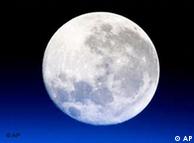
MIT mission to study moon's gravity
The Massachusetts Institute of Technology (MIT) will lead a 375-million dollar mission to map the moon's interior and reconstruct its thermal history.
According to a NASA announcement, the Gravity Recovery And Interior Laboratory (GRAIL) mission will be led by MIT professor Maria Zuber and will be launched in 2011.
The mission will put two separate satellites into orbit around the moon to precisely map variations in the moon's gravitational pull.
These changes will reveal differences in density of the moon's crust and mantle, and can be used to answer fundamental questions about the moon's internal structure and its history of collisions with asteroids.
The detailed information about lunar gravity will also significantly facilitate any future manned or unmanned missions to land on the moon.
Such data will be used to program the descent to the surface to avoid a crash landing and will also help target desirable landing sites.
Moreover, the mission's novel technology could eventually be used to explore other interesting worlds such as Mars.
"After the three-month mission is completed, we will know the lunar gravitational field better than we know Earth's," said Zuber, who is the head of the MIT's Department of Earth, Atmospheric and Planetary Sciences and the E.A. Griswold Professor of Geophysics.
She will be the principal investigator for the GRAIL mission.
Former astronaut Sally Ride, the first U.S. woman in space, will lead the project's educational outreach phase, which will include five live MoonKam cameras on each satellite that will be targeted by young students--especially middle-school girls--in their classrooms to get close-up still and video views of the moon's surface.
So far, even such fundamental questions as whether or not the moon has a separate, differentiated core, as Earth does, are unknown, Zuber says.
In addition to answering that question, the new mission should reveal details about lunar history, including the relative timing and effects of the myriads of huge impacts that created the craters and basins seen on the surface today.
The moon, with its airless, un-eroded surface, serves as a kind of Rosetta Stone for understanding the history of all the solar system's inner planets--Mercury, Venus, Earth and Mars--so the mission should also help to unlock secrets of the evolution of all these planets.
"The moon has the best-preserved record of the solar system's early history," Zuber says, while on other planets much of that record has been lost through erosion and other surface changes.
The technology used in the mission is a direct spin-off from the highly successful Gravity Recovery and Climate Experiment (GRACE) mission, which has been mapping Earth's gravitational field since 2002.
Using that technology made this a "low risk" mission for NASA because the necessary instruments had already been developed and tested.
As with that mission, GRAIL measurements of the gravitational field will come from very precise monitoring of changes in the distance between the two satellites.
The resulting measurements will map the moon's gravitational field up to 1,000 times more accurately than any previous mapping.
NASA selected the MIT-led mission from among two-dozen original proposals.
The GRAIL satellites will be built and operated by Lockheed Martin Space Systems of Denver, Colorado.
NASA's Jet Propulsion Laboratory in Pasadena, California will handle project management and developing the communications and navigation systems.
The mission's science team also includes David E. Smith of NASA Goddard Space Flight Center, who will be the deputy principal investigator, and other researchers from JPL, GSFC, the Carnegie Institution of Washington, the University of Arizona, the University of Paris and the Southwest Research Institute.

No comments:
Post a Comment